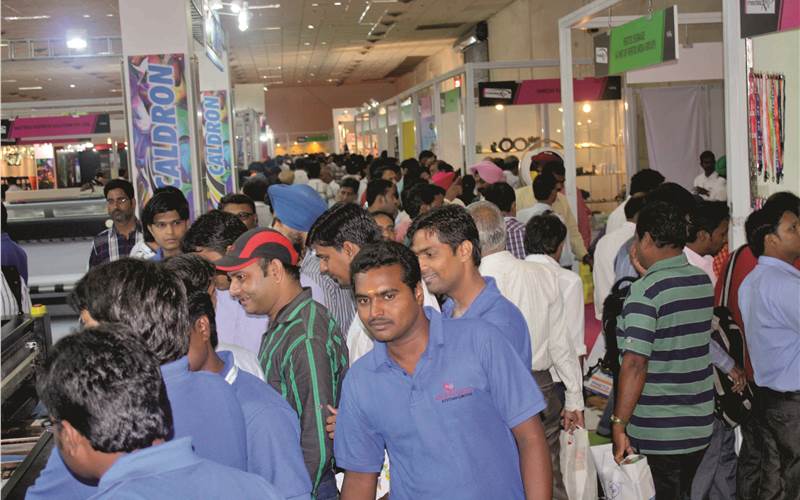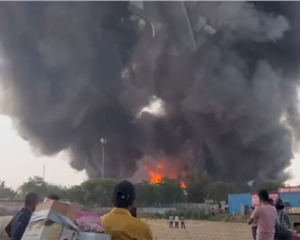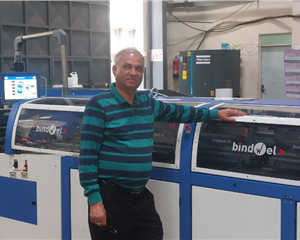At Media Expo, Supreeth Sudhakaran looks at how OOH occupies 6.2% of the total advertising space in India; and what this portends for the future of the wide-format printers and new applications
During the three days of the advertising and signage exhibition, Media Expo Delhi (held in Pragati Maidan from 27 to 29 July), over 22,000 visitors were welcomed by a fair mix of machines and consumables manufacturers, and some wide-format printing service providers. The principal reason why Media Expo Delhi could secure good number of visitors was its proximity to wide-format printing and signage hubs like Paharganj and Jhandewala.
According to our sources, there are around 1000-plus signage printers in Delhi NCR, of which around 20% utilise mid and high-end equipment to deliver solutions. The rest of the 80% of the market is scattered between mid-and entry-level printers and jobbers.
A mix of cynical and optimistic attitude underlined the conversations, this scribe had with leading wide-format players present at the show. Few insisted that scope of growth and expansions in the industry has kept it insulated from the economic slowdown. Others reported suffering a heavy dent in the business due to the Rupee devaluation and controlled marketing budgets of print buyers.
Nonetheless, the show offered one a prism to look at a spectrum of new applications and emerging niches in the wide-format printing market. In addition, the show helped at understanding and discussing trends that have been accepted by the market, and those still struggling to convince it.
Market perspective
The OOH (Out of Home) advertising industry in India is estimated to be worth Rs 1800cr. According to a report published by FICCI and KPMG, marketers spent approximately INR 16.5 billion in 2010 on OOH advertising which amounts to 6.2% of total advertisement spends. Scratch the surface, and we realise that OOH continues to serve as “filler” in the overall advertising strategy of brands. Static billboards continue to enjoy the lions share in the total mix and garner 55% of total OOH spends, but other mediums such as ‘in mall’ advertising, digital and transit media have registered the maximum growth.
“I have not seen a brand which has a legacy made only on OOH concept or implementation in India. Check on events, brands in India, OOH helps to fill in the reach gap of other key media like print and TV. They are short term. We do not even have an in-store branding other than Cadbury or Unilever or ITC which has a brand recall or specific branding concept emerged from this media, feels Chandan Mishra, manager – India region, Gandy Digital.
A critical reason for such hapazard growth can be attributed to the domination of flex as a commoditised space. “We have a flex market which constitutes the low-end flex business of banner material. 50% imported from China. Backlit and special material will be only 5-10% total consumption,” notes Mishra.
So what’s the mantra? Go niche
“The print service providers of Delhi NCR show keen interest in experimenting with technologies and new substrates to add value to their offerings,” says Gaurav Juneja, director of MEX exhibitions, organisers of Media Expo. And rightly so, one of the most prominent trend at the exhibition was applications and equipment targeted at textile, wallpaper and canvas printing.
At least four companies, Colorjet India, Apsom Infotex, Roland DG (see Product of the Month on page 70-71), Negi Sign and Systems reserved a space on their stands for displaying digital wide-format printers for handling textile substrates.
Colorjet India displayed its direct to fabric printer Softjet which can print up to 645 sqft in an hour. The machine uses dye sublimation direct ink and has a maximum printing width of 72.5inch. Negi Sign Systems had Mutoh Valuejet VJ 1638W aqueous printer on its stand. The four-color 64inch printer has a staggered dual head design that can print at speeds of up to 517sqft an hour using aqueous or dye-sublimation ink.
Roland and Apsom Infotex targeted the market with the 64inch Roland Versaart RA 640 dye-sublimation printer. The machine is equipped to produce droplets of seven different sizes to accentuate fine details of image at a maximum resolution of 1440 dpi.
Shiva Texyarn was one of the few exhibitors from the textile substrates segment at the show. The Coimbatore-based company displayed Intensipix— an acid-free textured digital inkjet canvas for printing— and Q-Print, an eco-friendly textile media that is compatible with several printing technologies. Shiva’s senior marketing manager, R Balakrishnan says that although digital canvas printing is at its nascent stage in India, the company is confident that it will taste the same success it achieved in several European nations.
Vehicle wrapping and wallpaper printing was another sub-genre that stood out. At the show, two print service companies, Eye Candy Visuals and Big Prints, focused on the niche market of printing wallpapers and vehicle wrapping seemed enthusiastic about the prospects.
Arjun Nanda of Eye Candy Visuals and Puneet Chadha of HP are optimistic about growth of this segment. “We are very bullish about the interior decor market moving towards digital printing. According to a study by Global Industry Analysts, the global market for wall coverings is forecasted to reach US$26 billion by the year 2015. In terms of most promising growth potential, Asia-Pacific, led by India is the clear winner,” notes Puneet Chadha, director – graphics solutions business, HP Imaging and Printing Group India.
“Although the market is facing a slight slowdown, wall and vehicle covering is expected to pick up in coming few months,” agrees Nanda, who has been using HP’s Latex printing to drive his web-to-print business.
The show also saw printing consumables specialist Max Flex & Imaging Systems launch its wall-print media. Hitesh Jobalia, managing director of Max Flex claims, Max Wall-Print Media will allow the advertising industry to switch from painting ads on all surfaces to printing ads on walls.
In Europe and US, clamours against the use of flex has been gaining momentum, has resulted in acceptance of alternative media such as vinyl and fabric as a viable media option in the signage industry. One could easily draw a tangent and believe the trend has seeped in to India.
However, print service providers like Nanda point out that the acceptance of textile as a substrate is primarily because print service providers are now trying to develop expertise in handling new substrates to gain an edge in market. “The general tendency is to take cognizance of new market opportunities and work towards it. Very less of it is motivated by the sentiment of going green.”
Debatable: Move towards eco-solvent and UV
Around 80% of the wide-format market in India is still driven by solvent printers. Lately, however, UV flatbed and eco-solvent wide-format printers have been slowly gaining traction.
Tapping the market for UV flatbed presses, Arrow Digital displayed Jetrix KX5 UV flatbed printer, which utilises Konica Minolta 1024 (6 picolitre) print head and prints at the speed of up to 30sqm/hour. Fujifilm India displayed its range of Acuity printers, while Monotech Systems formally announced that it has been chosen as the dealer for Israel-based Matan’s Barak range of grand format hybrid UV printers.
The show also saw Strategic Printing Solutions launching an upgraded version of its Shark eco-solvent printer in India. Strategic’s director, Sarabjit Singh Bedi says, “The growth in the adoption of eco-friendly technologies is making inroads in India as well. We have sold around 185 Shark 1 solvent printers since the launch in 2010.”
Atul Gandhi, director of the solvent wide-format printer manufacturing company, Macart Equipment doesn’t deny that UV and latex printing are gaining ground in the market but adds that the cost barriers associated with the technology has been a major hindrance.
|
Total number of machines in India (estimate) |
|
System
|
No. of printers |
Companies |
|
Solvent (production systems) printers |
150-200 |
Gandi Jeti, Vutek, HP XLJet |
|
Eco-solvent printers |
800-1,200 |
Roland, Mimaki and Mutoh |
|
UV printers |
100-150 |
Rastek, Dilli, Anapurna, HP Colorspan, Solara, Vutek QS, HP 6100, Jeti & Chinese makes |
|
Latex printers |
150+ |
HP |
|
Company-wise distribution of machines in India (estimate) |
|
Company |
Systems |
|
HP |
250 (12 UV, 7 Turbojets, 75 XLJets, 150+Latex |
|
Roland |
700-800 |
|
Mimaki |
150-200 |
|
Agfa |
50 (5 Annapurna, 45 Jeti) |
|
Gandy (new) |
1 Pred8tor |
|
Jetrix |
6-8 |
|
EFI |
26 (Vuteks – QS -6, GS-2); Rastek (18) |














 See All
See All